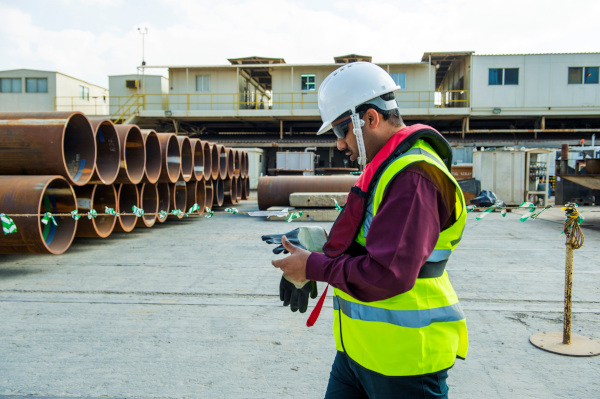US$800 Billion Investment Drive Accelerates Amid Rising Demand
_1.jpg) By Liesl Venter
By Liesl Venter
Opportunities for breakbulk are soaring in Africa, driven by exciting developments in oil, gas and LNG. From Issue 2, 2024 of Breakbulk Magazine, we pinpoint some worldscale projects to look forward to, and speak to AAL Shipping, GAC, and other industry leaders on how best to harness the project boom.
(You can read this article in 6 minutes)
Africa’s demand for electricity, coupled with its steadfast commitment to enhancing economic growth, continues to propel the oil and gas sector forward at an accelerating pace.
According to Ian Thom, upstream research director at Wood Mackenzie, the African upstream oil and gas sector is in the middle of an US$800 billion capital expenditure program that will see liquefied natural gas, or LNG, emerge as a significant investment theme alongside traditional deepwater oil.
Speaking to Breakbulk, Thom said there was no slowing down in the continent’s oil and gas demand. “Depending on your view for demand, the ongoing need for investment is estimated to be US$500 billion per year for the next few years, if not decades.”
This steadfast momentum in the sector promises growth and a flourishing trajectory that will reverberate across the continent’s project landscape for years.
Thom said the current 20-year investment cycle started in 2010 and would culminate at the end of the decade with world-scale LNG projects in Mozambique and floating LNG (FLNG) across at least five countries. Africa is already a leader in FLNG, with over 50 percent of global capacity.
“The potential for the emergence of more projects is exceptionally high,” Thom said, indicating while Africa was nowhere in the league of the U.S. or the Middle East or even close to the deepwater resources off the coast of Brazil, the continent still had a phenomenal resource base with established industries in the west, east, north and south.
“Africa already possesses a solid foundation ripe for further development and expansion, particularly evident in the established industries of West Africa, which have demonstrated the continent’s oil prowess. The increasing emergence and success of FLNG projects further amplify the overall optimism surrounding Africa’s oil and gas sector. With appropriate technologies and the requisite investments, projects are poised to advance by at least a decade compared to their feasibility in previous times.”
Unlocking Potential
John Pittalis, head of marketing and communications at AAL Shipping, shares the optimism around the African oil and gas sector. “Africa is an exciting market,” he said, indicating that the shipping line was actively looking for opportunities on the continent.
The Panama Canal Authority’s implementation of an extreme passage reduction measure due to a prolonged dry season had already led to AAL re-routing sailings from Asia, the Middle East, and Europe into the Americas and back via the Cape of Good Hope, South Africa.
“While this does mean an inevitable cost implication, it also allows us to call on African ports on both the West and East coasts regularly for backhaul cargoes into Europe, the Middle East, and Asia,” Pittalis said. These cargoes are typically primarily dry bulk, like iron ore, bauxite, and other commodities like rubber.
However, there is a growing potential for an increase in oil and gas-related cargo, especially as more countries across the continent intensify their efforts in this sector.
Gopalakrishnan Srinivasan, general manager for special projects – energy at GAC Group, said there had been a definite uptick in African oil and gas projects.
 “It is a rapidly developing region with many huge energy projects in comparatively unexplored markets gaining traction and causing flurries of activity. Service providers are clamoring to secure a local presence where they might not have one currently, much the same as they did in Guyana,” he told Breakbulk. “Project cargo volumes will certainly increase markedly. However, in these early stages of development, we are yet to see significant volume increases.”
“It is a rapidly developing region with many huge energy projects in comparatively unexplored markets gaining traction and causing flurries of activity. Service providers are clamoring to secure a local presence where they might not have one currently, much the same as they did in Guyana,” he told Breakbulk. “Project cargo volumes will certainly increase markedly. However, in these early stages of development, we are yet to see significant volume increases.”
The overall outlook, he said, is very positive. “Post Covid, no cold or warm stacked rigs exist. They are all operational. Oil prices continually increase and buoy the sector, leading to increasing drilling opportunities. However, there are not enough rigs to enable the drilling companies to make them available.
Consequently, the price of rigs is going up. It is a chain reaction with a knock-on effect causing reverberations throughout the sector.”
Srinivasan said GAC was seeing more refurbishment and reactivation of rigs due to the increasing drilling opportunities and the abovementioned shortages.
But, in the harsh African landscape, there was a growing emphasis on cost efficiency. “More than ever, customers are looking to drive down costs,” he said. “This imperative, along with the need to maintain operational excellence, has created a highly competitive environment where service providers continually strive to offer cost-effective solutions without compromising safety or quality standards.”
Navigating Complex Terrains
Operating in Africa’s project sector, irrespective of the industry involved, presents formidable challenges. Logistics service providers must constantly adapt and innovate, as errors can be prohibitively expensive— the vast expanses of remote terrain and deficient infrastructure demand unconventional solutions, often necessitating trial and error.
“The oil and gas sector in Africa faces significant challenges due to inadequate infrastructure, lack of investment and global pressures to abandon hydrocarbons,” said NJ Ayuk, executive chairman of the African Energy Chamber, or AEC.
“A reliance on foreign personnel for projects often leads to high costs while delays in getting projects from discovery to development impact revenues. Additionally, global energy transition policies impact oil and gas investments worldwide.”
According to Ayuk, African governments have made strides in improving regulations, making for easier operation on the continent, often cited as one of the biggest hurdles. “There is a need for limited government intervention and a greater emphasis on fostering free markets to attract direct investments and encourage increased private sector participation.”
AEC figures note that Africa is home to around 125.3 billion barrels of crude oil and 620 trillion cubic feet of gas. “Oil and gas – and the projects they bring – will remain an integral part of Africa’s future for years to come,” Ayuk said. “It is one of the final frontiers for oil and gas exploration, and we can see that in the number of projects on the continent.”
In Every Corner
That is evident in every region on the continent. The massive gas finds and ongoing projects in Mozambique have been extensively documented, with two significant LNG projects steadily developing. Additionally, the BP Tortue Ahmeyim project on the maritime border between Mauritania and Senegal has garnered considerable media coverage.
Notably, Tanzania, Uganda, and Morocco are also advancing projects in the sector. Moreover, countries like Namibia, Angola, and Nigeria actively pursue various oil and gas initiatives, further contributing to the region’s energy landscape.
According to Ayuk, Namibia is a fascinating frontier, having made six hydrocarbon discoveries in just two years. Zimbabwe’s potential onshore gas market also represents an exciting play, while upstream investments in Angola, Libya and Uganda are poised to unlock significant finds. Downstream projects include the East African Crude Oil Pipeline, the Dangote Refinery in Nigeria, the Central African Pipeline System, and Equatorial Guinea’s Gas Mega Hub.
“LNG seems to have found its niche in Africa,” Wood Mackenzie’s Thom said. “In Mozambique, expansion plans for the FLNG projects already exist, and several operators are looking at developments in Nigeria. The Tortue projects recently saw the first vessels arrive on site. These indicate the oil and gas project sector continuing its upward trajectory.”
Thom highlighted that the necessary upfront investments are one of the most significant hurdles in the oil and gas sector. These projects often entail lengthy lead times spanning several years, demanding partners with substantial financial resources for investment. “Only a select few companies with deep pockets possess the capability to undertake such ventures. Consequently, we expect to see the less financially viable projects postponed or put on hold for now.”
External Pressures
According to Srinivasan, offshore projects face global inflationary and supply chain pressures, which raise uncertainties in long-term commercial and investment decisions. “Further, their financial viability is coming under scrutiny amid rising energy prices and costs of raw materials used in the construction and servicing of offshore installations. The upturn brings significant supply chain challenges for our customers.
 “Without the necessary infrastructure and expertise, there is a risk that transportation bottlenecks could develop, and compliance with increasingly strict regulations can add further obstacles. Further, every project brings with it a requirement for accessible, secure warehousing, yard storage, associated facilities and equipment.”
“Without the necessary infrastructure and expertise, there is a risk that transportation bottlenecks could develop, and compliance with increasingly strict regulations can add further obstacles. Further, every project brings with it a requirement for accessible, secure warehousing, yard storage, associated facilities and equipment.”
Tackling these supply chain challenges will be critical for success, Ayuk said, emphasizing that significant infrastructure investment will be required across the continent.
“Infrastructure is the foundation for a successful oil and gas industry. Initiatives to bolster infrastructure will be required, including investments by the government alongside the private sector, regional collaborations, the upgrading and construction of pipelines, terminals, and cross-border infrastructure, local content development and technology adoption.”
Carl Webb from Project Logistics Management highlighted the importance of engaging breakbulk and project cargo specialists right from a project’s inception. Landside operations, he noted, are contingent upon factors such as site location and proximity to ports. However, accessibility, especially for oversized or heavy cargoes, can be challenging in Africa. Therefore, consulting with project cargo experts is advisable and essential for navigating these complexities effectively.
But, according to Ayuk, while challenges will always prevail, the flow of capital remains steady, mainly as more African governments aim to increase production and global demand grows. “International majors such as Eni, TotalEnergies, BP and ExxonMobil are directing investments in exploration initiatives across the continent. Simultaneously, governments are doing their part to attract new investors,” he said.
Africa’s substantial investments in seismic data acquisition reflect a commitment to comprehensively understanding its untapped resource potential, he said. “Proactive regulatory enhancements, exemplified by initiatives such as Nigeria’s Petroleum Industry Act and Ghana’s Gas Master Plan, aim to create favorable investor conditions.”
For the project sector, this is excellent news. It’s crucial, however, for companies aiming to seize opportunities to stay informed about developments and maintain a regional presence as it is an environment that requires local knowledge and expertise for success.
AAL Shipping and GAC Group will be exhibiting at Breakbulk Europe 2024, taking place on 21-23 May at Rotterdam Ahoy.
PHOTO CREDIT: GAC Group


